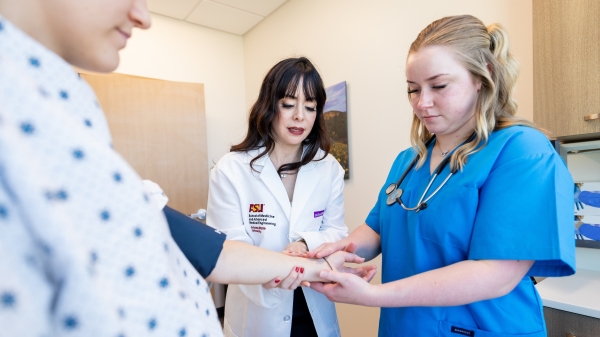ASU study shows middle-aged Americans are lonelier than European peers

New research published in American Psychologist shows middle-aged Americans are lonelier than their same-age peers in Europe and Israel — and that levels of loneliness are increasing across generations in both the U.S. and in Europe. Photo by Bob Price/Pexels
Contrary to some claims, middle-aged Americans might not be experiencing an epidemic of loneliness. New research suggests that for adults aged 45–65, loneliness might instead be endemic, or constantly present.
Loneliness is not just an emotion. It can seriously impair physical health, and its negative effects have been likened to smoking up to 15 cigarettes a day. But new research shows that not only are middle-aged Americans lonelier than their same-age peers in Europe and Israel, levels of loneliness are also increasing across generations in both the U.S. and Europe.
“Middle-aged Americans are experiencing very high levels of loneliness, especially baby boomers, but middle-aged adults in England, Italy, Spain, and Greece are now ‘catching up’ to their American peers,” said Frank Infurna, associate professor of psychology at ASU.
The study, which was led by researchers in Arizona State University’s Department of Psychology, part of The College of Liberal Arts and Sciences, has been published in American Psychologist.
More than a feeling
Feeling lonely arises from a mismatch between actual and desired levels of connection with other people. Loneliness is getting a lot of attention as a public health issue — the U.S. surgeon general recently issued a health advisory focused on the impacts of loneliness and spoke on this topic during his visit to ASU — but the root causes are not well understood.
The study was based on long-term datasets made up of nationally representative samples of adults ages 45–65 living in 14 countries. The data sets included the Health and Retirement Study for the U.S.; the English Longitudinal Study of Ageing for England; and the Survey of Health, Ageing and Retirement in Europe for Austria, Belgium, France, Switzerland, Germany, Italy, Spain, Greece, Denmark, the Netherlands, Sweden and Israel.
The researchers mapped out loneliness trends based on geography and through time by examining differences across generations in the different countries.
Across all 14 countries, baby boomers reported the highest overall levels of loneliness, but American baby boomers far outpaced their peers.
“Americans in this cohort reported much, much higher levels of loneliness than same-aged adults in other countries; the magnitude of this difference is alarming and is cause for concern,” said Infurna.
The geographic pattern was different for Generation X, with Americans reporting higher levels of loneliness relative to all other countries except for England.
How loneliness progresses with age
The researchers examined how loneliness changed within each generation by tracking reported levels from participants as they aged from 45 to 65.
U.S. baby boomers born in 1946–54 experienced increasing loneliness as they approached age 65. For U.S. baby boomers born after 1955, the reported loneliness remained constant — and very high. This increasing trend was also present in Generation X.
Reported loneliness was stable for baby boomers in England, Austria, France, Belgium, Germany, Switzerland and Israel.
In Italy, Spain and Greece, though, loneliness steeply increased across ages 40–65 for baby boomers and for Generation X.
Overall, middle-aged adults from all generations living in Denmark, the Netherlands and Sweden experienced the lowest levels of loneliness among all 14 countries included in the study. But, baby boomers again reported the highest levels of loneliness in these three countries.
According to Infurna, this study is a first step at addressing loneliness — whether it is just epidemic or endemic.
“Though there are effective ways that individuals can work to reduce isolation and loneliness, such as volunteering in the community, there is an urgent need for systematic support, for programs that aid adult caregivers and that provide financial assistance. These types of supports can help middle-aged adults juggling work and caregiving have the time and means to connect with others.
"The findings of this study are suggestive of this as well — middle-aged adults reporting the lowest levels of loneliness live in countries with robust government-supported safety nets,” Infurna said.
Nutifafa Dey, a psychology graduate student at ASU; Kevin Grimm, professor of psychology at ASU; Margie Lachman, professor of psychology at Brandeis University; Tita Gonzalez Aviles, postdoctoral scholar at Humboldt University Berlin; and Denis Gerstorf, professor of psychology at Humboldt University Berlin, also contributed to the study.
This work was funded by the National Institute on Aging.
More Health and medicine

Linguistics work could improve doctor-patient communications in Philippines, beyond
When Peter Torres traveled to Mapúa University in the Philippines over the summer, he was shocked to see a billboard promoting Arizona State University.“It wasn’t even near the university,” said…

Turning data into knowledge: How Health Observatory at ASU aims to educate public
This is how David Engelthaler described his first couple of months on the job as executive director of the Health Observatory at Arizona State University:“It’s been a little bit of drinking from the…

HonorHealth named primary clinical affiliate for new ASU School of Medicine and Advanced Medical Engineering
Arizona State University and HonorHealth, a locally owned nonprofit health system, announced today that they have finalized an agreement for HonorHealth to serve as the primary clinical affiliate for…